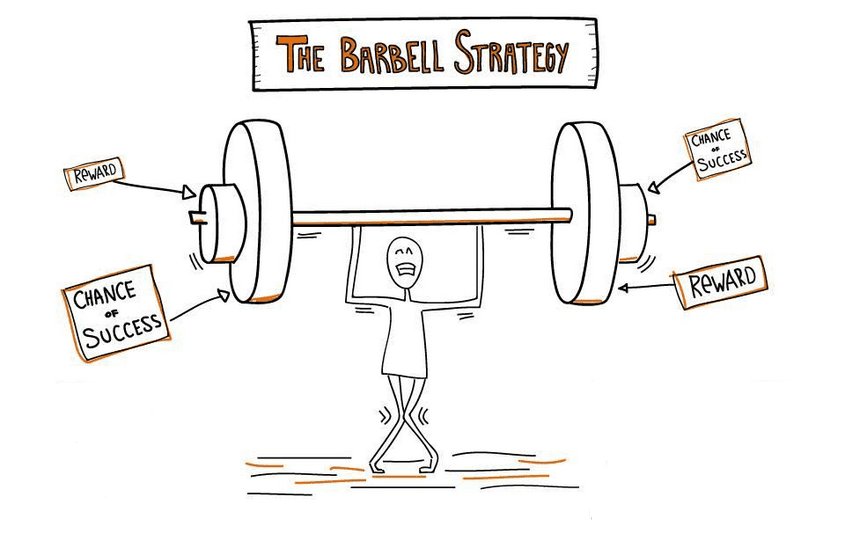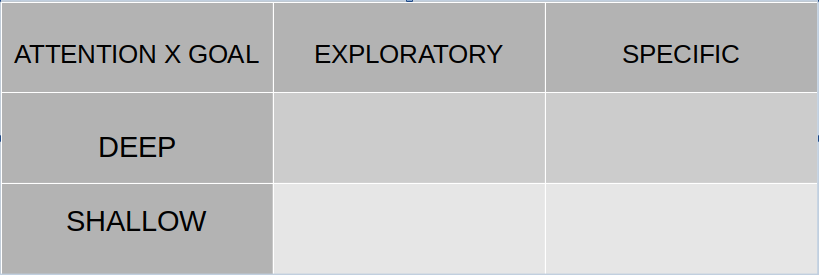Subscribe to our RSS here.
Adding Chaos to Learning
One of the worst expectations schools create in young folk is that structure and the best path will be handed to them by default.
On initial levels on education - but not uncommonly extending until bachelors programs, and even on the professional academic field - the steps, points, levels, and requirements will appear.
Have you ever stumbled on any from beginner to advanced list?
It’s understandable the search for such guidelines: They represent a path and connect the dots.
However, there are three major problems with such approach:
1 - The dots are already connected: Any guide will be proposed by someone - meaning that it will carry any pre-concept from this person or group about what is important and how things are related. Hardly it will match what is important to you and how things should related in your context.
2 - It doesn’t allow exploration: “The path is this” can speed up your walking towards the final destiny, however, it does not (or hardly does) allow you to see what is around the path. Every problem and concept is multifaceted; and every course will show you just a handful of these points of view.
3 - You are protected from mistakes: Have you ever taken a course where the instructions were to look at the raw documentation and try out many things that will end up being wrong?
…Yeah…
I haven’t as well.
And these mistakes provide deeper and broader understanding of the problem.
So, how to fight out of this situation without re-inventing the wheel?
Following a Barbell Strategy, we can mitigate the bad aspects of structured learning paths with some chaotic and unstructured learning. By exploring unknown unknowns we can broad our chances to find opportunities that can shift drastically our learning.

The Learning Quadrants
After reflecting on my typical learning schedule, I’ve realized that I could categorize the ways I absorb information in 4 areas
Let’s call them The Learning Quadrants:

The Axes: Attention and Goal
The Quadrant has two axes of interpretation.
The Attention axis is related to the level of concentration used during the learning process.
For instance, if I am reading a technical book and taking notes, I can classify this activity as Deep in Attention, because I close my mind to any other sort of information*. On the other hand, if I am copying information from hand-written notes to a mindmap software, probably my mind can be significantly free - therefore, I can say this is a Shallow in Attention activity.
* I like to listen to music during Deep Attention activities, but they serve just as background noise.
The second axis is related to the level of structure in the activity - the Goal axis. Back to the technical book, if my goal is to read it cover to cover throughout months to master its topic, I can say that this is a Specific Goal activity. However, if I will watch 15 Youtube videos talking about investments, programming, testing, fitness, and the latest political scandal, I can say this is a Exploratory Goal activity: I am learning all the time, but the goal is to walk around as much as possible in the hope to stumble in something interesting eventually…
Examples in the Four Areas
What can we fit in each area?
Quadrant 1: Shallow and Exploratory
This is the more relaxed area. Most of the times, these activities are performed to avoid wasting time in our daily routines.
Out of the top of my head, I can think of:
-
Reading (or listening) aphorisms / personal development books while commuting;
-
Talking to friends about some interesting topic in a bar;
-
Watching random (and somehow) educational videos (cat videos do not count);
-
Skimming blog posts from HackerNews.
Quadrant 2: Shallow and Specific
Here we are adding some more structure by focusing on a single topic, by engaging in it continuously during a good period (few weeks), but usually the time dedicated to the activities will make the learning shallower.
Shallow and Specific could be…
-
Watching a programming Youtube playlist while eating popcorn all the time, without practising;
-
Reading a philosophy or technical book as it was a fiction book;
-
Discussing freely with a friend about a topic.
Quadrant 3: Deep and Exploratory
In this Quadrant, the activities will take more time and focus a bit more on a specific topic, but the learning ends on one or two instances of this activity.
-
Watching conference talks, where the topic is exhausted in 40-90 minutes;
-
Reading blog posts that got my attention in a slower pace;
-
Discussing in real-time forums, such as Ministry of Testing’s Slack channel.
Quadrant 4: Deep and Specific
Here we will add planning and concentration to our learning, because the goal is to deep dive on a topic:
-
Learning a programming language or a complex tool;
-
Reading a philosophy book as one should do it.
Structuring your Day
The understanding on how we can classify learning enable us to use our daily mental energy to efficiently plan our activities and keep a consistent routine.
The specifics of how many activities of each quadrant one will tackle every day is a very personal choice, however, I can suggest some tips:
-
Do not focus on one quadrant each day: The rationale is that the Deep quadrants demand high levels of concentration - which cannot be kept for long periods of time - and the Shallow quadrants are way too relaxed, which make difficult to jump into a whole day of concentration afterwards;
-
Give the proper timeslot for each quadrant: Quadrant 4 demands consistent and long (1 hour minimum) periods, because you go into the more complex aspects of a topic; either giving too short periods or long intervals between activities will not allow your brain to connect the dots in a permanent way. On the other hand, it’s clear if you spend too much of your day on the Shallow activities you will not have enough time for Deep activities;
-
Do not skip the Specific quadrants: These quadrants are where you will engrave in your brain the knowledge, but the continuos and self-reflective exposition to the topic. Skipping these activities will put you in a position of saying “I’ve heard about it, but I have no idea of the details or know-how”;
-
Do not skip the Exploratory quadrants: These quadrants serve to open your mind new topics and perspectives, through the exposition to multiple small pieces of knowledge, at “low cost” (of time). Skipping these activities not allow you to discover new items for your tool belt and making you deep into Specific activities that are not optimal for your goals.
Nothing is Static
One of the most interesting aspects of the Learning Quadrants is that they serve as a production line for knowledge topics, where they pass through “filters” of interest analysis. The same topic can go from Quadrant 1 to Quadrant 4 in a smooth way according with the impression of importance you have of the that.
Let’s have an example:
- Quadrant 1: While reading Hacker News, you may hear about Logic Programming with Prolog. You spend 5 minutes scrolling through a blog post about it, reading that the following piece of code asks the computer if Socrates is mortal, given that Socrates is a man and all men are mortals.:
man(socrates).
mortal(X) :- man(X).
?- mortal(socrates).
-
Quadrant 2: You found this Logic Programming thing cool, so you spend 10 minutes per day on the following week watching some Youtube videos on it, getting a bit more familiar with the syntax;
-
Quadrant 3: You want to try out some coding, to get your fingers and brain familiar to thinking in Prolog, so you copy-and-paste some code from Learning X in Y Minutes, try to change one thing and other to explore what is the program reaction. Additionally, you watch some conference talks about deeper usage of Prolog. You can spend one or two weeks on this, but now you are giving 20-30 minutes per day for Prolog.
-
Quadrant 4: You realize you want to get really good at Prolog. You buy some books such as Prolog Programming for Artificial Intelligence and Expert Systems in Prolog, take notes of your reading and practicing the specific exercises and building some small projects. Additionally, you may want to engage in an open source project, such as Zamia AI. This is a slow and consistent process, from a few weeks to a few months, with isolated periods of 1-2 hours of total engagement in learning Prolog.
Conclusion
When we left school, it’s easy to get frustrated in learning new things, both because now we have less time available for such and also because (and specially) it’s hard to allocate the remaining time efficiently. Feelings of be learning something useless or not be focusing on learning anything come when we d0on’t think about our learning.
In school, this thinking was already done for us. Outside it, we need to take over the responsibility with ourselves to become master of our craft and mind. The Learning Quadrants can be used to understand how are we learning things and if we are using our time in the better way possible.

Leave a comment